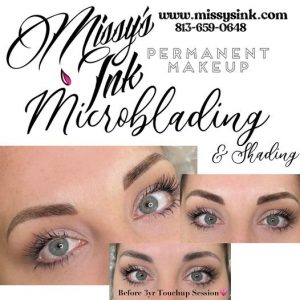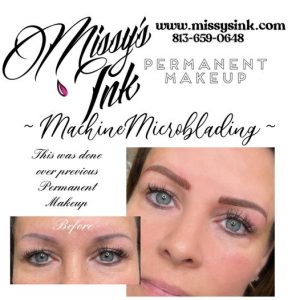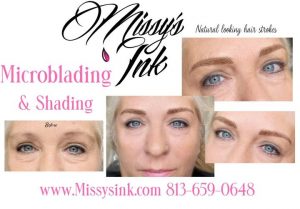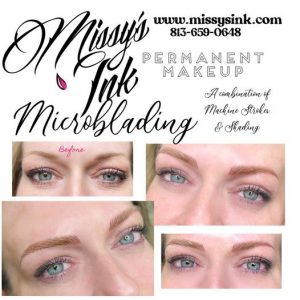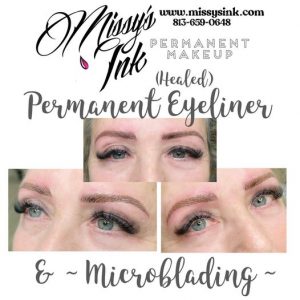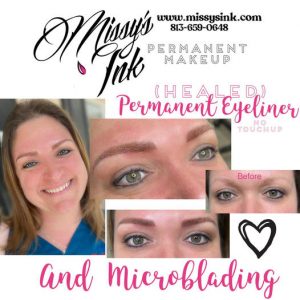
**Please see the above pull-down menu for pricing information.** or click this link: Pricing (missysink.com)
What is Microblading? Microblading is a manual “hand” method of permanent cosmetics for your eyebrows which creates extremely fine natural looking hair strokes. The results? Perfectly natural looking, thick, full brows. How long does Microblading last? Depending on your skin type and care, the pigment will fade slowly over 18-24 months. Is Microblading painful? The service can be a little uncomfortable for those who are more sensitive. However, there is an anesthetic applied during to keep this to a minimum to where it is completely tolerable.
How does it work? The pigment is applied with a specific tool that has a row of several fine needles to create thin hair like marks in the skin. Your artist will choose needles and the blade type according to the technique and the skin type. The pigment is bladed just below the epidermis and the most shallow part of the dermis, making extremely fine natural looking hair strokes. A very natural result is achieved, as the hairs are bladed into the skin according to the natural hair growth direction. A touch up is to be expected and is recommended after 4-6 weeks, after your initial treatment to address any issues that may arise during healing. Most permanent makeup procedures are a two step process
How long should I expect my microblading procedure take? The appointment should take about two hours. Are there any pre-existing conditions that interfere with consideration for a Microblading treatment? • Pregnancy • Breastfeeding (treatment is possible, though anesthetic will not be possible) • On keloids or if you have tendency to keloid, birthmarks or moles. • Diabetic. • Serious diseases such as cancer, epilepsy, autoimmune disorders (doctor’s note is required) • Circulatory disorders (doctor’s note is required) • Any bleeding disorders (doctor’s note is required) • You’re taking blood thinning medication • Currently on Accutane or other strong retinoids (must wait until 6 months after treatment ends) • If any skin diseases symptoms or irritation appears on the area. • You’ve recently had Botox or Disport treatment (must wait 2 months) • Old PMU • You have a broken capillary in the eyebrows area • If you have a sunburn. • After waxing (must wait 3 days) • After chemical peels (must wait two weeks)
Is there anything I need to do to prepare for my service? • Do not drink coffee, alcohol or energizing drinks on the day of treatment. • Do not take Aspirin, Niacin, Vitamin E or Ibuprofen 24 hours before treatment. • Do not take omega3 (fish oil) 1 week before treatment. • Do not tan or have intense sun exposure 3 days before treatment. • No waxing 2-3 days before treatment. • No chemical peels, dermabrasion, laser or any other intense treatments 2 weeks before treatment. • Shower and fix your hair as you need to take extra care not to get your brows wet for several days. What can I expect during my service? Here’s a quick rundown of a typical service provided by Missy’s Ink:
Missy will draw on the eyebrow shape by using a measuring tool. Brows are measured perfectly to complement your unique face shape and size.
Next, Missy will choose the perfect pigment color.
- Initial strokes are placed, then anesthetic is applied to reduce any discomfort.
- Pigment is worked into each stroke to define the brow.
- After, a pigment mask is left to absorb into the skin.
- Once that’s finished, Missy will clean the area thoroughly.
- After the service, Missy will apply an ointment to keep the brows moistened.
Is there any after-procedure care? Yes! Make sure to avoid ALL of the following: • Increased sweating, practicing sports, swimming, hot sauna, hot bath or jacuzzi, sun tanning or salon tanning. • Any laser or chemical treatments or peelings, and/or any creams containing Retin-A or Glycol Acid on the face or neck. • Picking, peeling or scratching of the micro pigmented area in order to avoid scarring of the area or removal of the pigment. • Performing tasks related to heavy household cleaning such as garage or basement cleaning where there is a lot of airborne debris. • Drinking alcohol in excess as it may lead to slow healing of wounds. • Driving in open air vehicles such as convertibles, boats, bicycles or motorcycles. • Touching of the eyebrow area except for when rinsing and applying the post-care cream with a cotton swab. • Before showering apply a layer of post-care cream to protect your eyebrows from moisture. During the shower keep your face away from the shower head. Itching and flaking may appear during the first seven days post microblading procedure, However, experience has shown that by following these aftercare instructions these symptoms may quickly disappear. • Once completely healed, always apply a layer of sunscreen SPF 30 on your eyebrows when exposed to the sun. Sun exposure might cause the color pigment to fade away more quickly. What happens during the touch up? The touch up is recommended 4-6 weeks after initial treatment. During your touch up, Missy will fill in missing hairs, add or make hairs longer or just achieve a darker color. What’s the Microblading healing process like? Your new eyebrows will go through several phases during the healing cycle. True reflection of healed color can only be assessed 3-4 weeks after treatment. Touch-ups and/or correction of the shape/design is recommended at least 4 weeks after initial treatment. It will go from too dark, to too light, to just right! Immediately after the procedure, the pigment will appear very sharp and dark. This is because the pigment is still seating on top of your skin and has not yet settled in completely. The color of the pigment will soften gradually (do not be alarmed if you see some pigment on the cotton swab as this is excess pigment and/or body fluid that is naturally exiting your skin). Once the healing of the skin starts taking place it will look like dandruff flakes or dry skin. This might give you the impression that the color pigment is fading too quickly. However, this is just superficial color and dry skin being naturally removed from your eyebrows. Your eyebrows will be the lightest tones during days 5-12 because the color is absorbed in the deeper layers of the skin. Later skin cells push it back to the upper layers. Once the healing is completed, you will enjoy a pair of beautiful, new, natural looking eyebrows.
More information about Microblading:
Microblading Fact Sheet
Is it tattooing?
With the sudden popularity and media attention to the term microblading, many are led to believe microblading is not a tattoo process. Permanent cosmetics, micropigmentation, dermal implantation, microblading/microstroking, eyebrow embroidery, and long-time/long-lasting makeup, are all different names for the same procedure – cosmetic tattooing. Any time color is placed into the skin with any device, it is a tattoo process as defined by many well informed regulators, the medical community, and dictionary sources. Denying this process is a tattoo can be problematic for those who would, for religious or other personal reasons, normally refuse to have a tattoo.
Is a blade being used to perform the microblading tattoo procedure?
Microblading is performed with a grouping or configuration of needles affixed to a handle to manually create lines that resemble eyebrow hairs. Manual methods of tattooing have been used through the ages, and the tools have gone through changes over time from pre-historic sharpened stones to the hand tool devices currently being used. An actual scalpel or cutting-type blade should not be used under any circumstances as these are considered medical devices and cannot legitimately be used for this process. Any hand tool device (i.e., both handle and attached needles) used for microblading should be pre-sterilized and fully disposable.
Is it semi-permanent?
Some are promoting microblading or eyebrow embroidery as a semi-permanent process; and that the color only reaches the epidermal (outer) layer of the skin. A careful review of basic skin anatomy and physiology would reveal this is not true. By definition and tattoo industry standards, color is tattooed/implanted into the dermis of the skin. If pigment particles do not reach the dermis, they will disappear during the healing phase of the skin, during normal regeneration of cells at the epidermal level. Pigments do fade in the skin over time, but that does not make the process semi-permanent. It is impossible to predict how much pigment will fade away and how long it will take to do so with any measure of consistency or reliability.
Why does microblading not last as long as other eyebrow tattooing techniques?
This is simply because a much smaller amount of pigment is inserted (tattooed) into the skin as compared to fully or solidly filled eyebrow tattoos.
